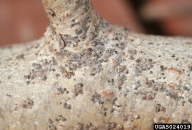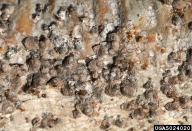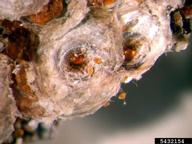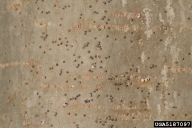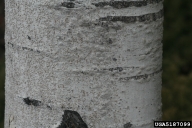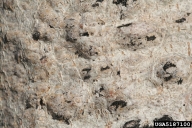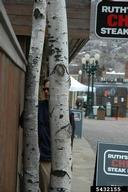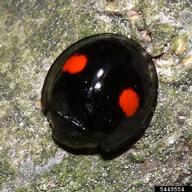Willow scale
Diaspidiotus gigas (Thiem and Gerneck) (Hemiptera: Diaspididae)
Orientation to pest
Willow scale, Diaspidiotus gigas (Thiem and Gerneck), is an invasive scale found in North America. It is also widely distributed across the northern temperate zone in the Old World, from Algeria and western Europe to Siberia and China. It has one generation per year in the northern United States and overwinters as partly grown nymphs or young adults. It feeds on branches of species of willow (Salix) and poplar (Populus) and is found on both shade trees and in natural vegetation.
Hosts commonly attacked
Willow scale feeds on species of willow (Salix) and poplar (Populus).
Distribution
This scale is found across the United States, with specimens recorded from both western parts of the country (Oregon, Washington, Idaho, Montana, Colorado, Utah, and Wyoming), the midwest (Wisconsin, Ohio) and the northeast (New York, Pennsylvania, Rhode Island). It is also found in eastern Canada (Nova Scotia, New Brunswick, Ontario).
Images of willow scale
| Figure 1. Mixed stages of willow scale, Diaspidiotus gigas, on trunk of an aspen tree | Figure 2. Close up view of mixed stages of willow scale on aspen | Figure 3. Crawlers of willow scale escaping from female scale | Figure 4. Overwintering stage (2nd instar nymphs) of willow scale on bark |
| Figure 5. Two views of damage from willow scale to aspen bark; left view of whole trunk showing "bubbling" or pitting effect on bark (middle of photo) and on right, close up of damage. | Figure 6. Aspen trees in Aspen, Colorado, that are heavily infested with willow scale | Figure 7. Chilocorus kuwanae, a predator of willow scale in its native range in China | |
Important biological control agents related to this pest species
The aphelinid parasitoids Pteroptrix longgiclava (Girault) and Encarsia gigas (Tshumakova) attack willow scale in China and are attracted to volatiles from the scale, suggesting these may be specialized species of value in biological control. Other parasitoids known to attack this scale in Europe or other regions include Aphytis mytilaspidis (Le Baron), Pteroptrix dimidiatus (Westwood), and Azotus matritensis Merc. Aphytis mytilaspidis, however, is a widely distributed polyphagous species that attacks many diaspidids. Predators known to feed on this scale include Chilocorus kuwanae Silvestri (an Asian ladybird already introduced into North America for control of another invasive scale, Unaspis euonymi [Comstock]), Chilocorus bipustulatus (L.) and Coccinella bipunctata ( L.). The native North American species Chilocorus stigma has been observed feeding on D. gigas in Colorado. Other potential willow scale predators known from Europe include the predatory bugs Loricula pselaphiformis Curt. and Loricula elengatula Baerensprung (Microphysidae) and the anthocorids Ectemnus nigriceps E. Wagner and Temnostethus longirostris (Horv.).
Web links for information on willow scale
- Fact Sheet | Colorado State University Extension
- Species Catalog on ScaleNet
Complete list of all recorded natural enemies, hosts, and distribution records; also an index to all publications on this species
Articles
- Lelláková-Dusková, F. 1963. The morphology, metamorphosis, and lifecycle of the scale insect Quadraspidiotus gigas (Thiem and Gerneck). Acta Entomologica Musei Nationalis Prague 5: 611-648.
- Nakahara, S. 1982. A Checklist of the Armored Scales of the Coterminous United States. Plant Protection and Quarantine Animal and Plant Health Inspection Service, United States Department of Agriculture. 110 pp.
- Chi, D. F., S. C. Yan, X. H. Zhao, and Z. H. Wen. 2003 The taxis of chalcid parasitoids to their host and analysis of the volatile[s] from fixed first instar nymph[s] of Quadraspidiotus gigas (Thiem & Gerneck). Journal of Northeast Forestry University 31(2): 20-22.
- Chi, D. F., R. O. Rubio, S. C. Yan, D. D. Zhang, and Z. H. Wen. 2002. Foraging behavior of parasitoid chalcid to the essential oil from bark of Populus pseudo-simonii x P. nigra and Quadraspidiotus gigas. Journal of Forestry Research 13(4): 255-259.
- Ma, L., C. D. Li, J. Q. Liu, Y. Sun, X. L. Wang, Y. J. Ji, W. S. Du, L. Yang, G. L. Su, and B. H. Zhao. 1997. Predatory function of Chilocorus kawanae Silvestri on Quadraspidiotus gigas (Thiem et Gerneck). Journal of Northeast Forestry University 25(2): 64-67.
